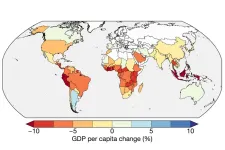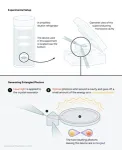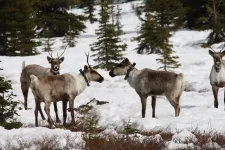(Press-News.org) In the years it strikes, the band of warm ocean water spanning from South America to Asia known as El Niño triggers far-reaching changes in weather that result in devastating floods, crop-killing droughts, plummeting fish populations, and an uptick in tropical diseases.
With El Niño projected to return this year, Dartmouth researchers report in the journal Science that the financial toll of the recurring climate pattern can persist for several years after the event itself—and cost trillions in lost income worldwide. The study is among the first to evaluate the long-term costs of El Niño and projects losses that far exceed those estimated by previous research.
El Niño is the warm phase of the El Niño-Southern Oscillation, the natural cycle of warm and cold temperatures in the tropical Pacific Ocean that includes La Niña, El Niño’s cooler counterpart. El Niño alters weather patterns worldwide and, in the United States, typically results in wetter, warmer winters for the West Coast and a milder hurricane season on the Atlantic seaboard.
The researchers spent two years examining global economic activity in the decades following the 1982-83 and 1997-98 El Niño events and found a "persistent signature" of slowed economic growth more than five years later. The global economy bled $4.1 trillion and $5.7 trillion, respectively, in the half-decade after each of these events, most of it borne by the world’s poorest nations in the tropics.
The researchers project that global economic losses for the 21st century will amount to $84 trillion as climate change potentially amplifies the frequency and strength of El Niño—even if current pledges by world leaders to reduce carbon emissions come to fruition. The researchers estimate that the El Niño predicted for 2023 alone could hold the global economy back by as much as $3 trillion by 2029.
Lead author Christopher Callahan, a doctoral candidate in geography at Dartmouth, said the study addresses an ongoing debate about how quickly societies rebound from major climate events such as El Niño.
"We can say with certainty that societies and economies absolutely do not just take a hit and recover," said Callahan, adding that their data suggested a downturn after El Niño could last as long as 14 years, if not longer.
"In the tropics and places that experience the effects of El Niño, you get a persistent signature during which growth is delayed for at least five years," he said. "The aggregate price tag on these events has not ever been fully quantified—you have to add up all the depressed growth moving forward, not just when the event is happening."
Senior author Justin Mankin, an assistant professor of geography, said the findings highlight a critical and understudied factor shaping the economic toll of global warming—year-to-year variations in climate conditions. While these swings are largely independent from global warming, they can amplify or diminish its effects. Once described as the "trunk of the tree of climate variability," El Niño is the largest and most important source of year-to-year climate variation, altering weather around the world and resonating across national economies.
When it comes to climate change, world leaders and the public rightfully focus on the unabated rise in the global average temperature, Mankin said. "But if you're estimating the costs of global warming without considering El Niño, then you are dramatically underestimating the costs of global warming."
"Our welfare is affected by our global economy, and our global economy is tied to the climate," Mankin said. "When you ask how costly climate change is, you can start by asking how costly climate variation is. We're showing here that such variation, as embodied in El Niño, is incredibly costly and stagnates growth for years, which led us to cost estimates that are orders of magnitudes larger than previous ones."
Callahan and Mankin found that the 1982-83 and 1997-98 events caused the gross domestic product of the United States to be approximately 3% lower in 1988 and 2003 than it would have been otherwise. But in 2003, the GDPs of coastal tropical nations such as Peru and Indonesia were lower by more than 10%.
“The global pattern of El Niño’s effect on the climate and on the prosperity of different countries reflects the unequal distribution of wealth and climate risk—not to mention the responsibility for climate change—worldwide,” Mankin said. “El Niño amplifies the wider inequities in climate change, disproportionately impacting the least resilient and prepared among us.”
"The duration and magnitude of the financial repercussions we uncovered suggests to me that we are maladapted to the climate we have," he said. "Our accounting dramatically raises the cost estimate of doing nothing. We need to both mitigate climate change and invest more in El Niño prediction and adaptation because these events will only amplify the future costs of global warming.”
The 2023 El Niño is predicted to come at a time when sea-surface temperatures are at an all-time high, Callahan said. The last major El Niño occurred in 2016 and made that year the hottest in recorded history. Global warming has only intensified in the seven years since. In addition, the world is coming out of an extended La Niña and the two phases can strengthen each other. The National Oceanic and Atmospheric Administration projects the chances of El Niño setting in by late summer as higher than 80%.
"The deck is potentially stacked for a really big El Niño," Callahan said. "Our results suggest that there will likely be a major economic toll that depresses economic growth in tropical countries for potentially up to a decade. The result could be trillions of dollars in productivity lost globally relative to a world without this El Niño."
The paper "Persistent effect of El Niño on global economic growth" was published May 18, 2023, by Science. The research was funded by a Graduate Research Fellowship (1840344) from the National Science Foundation; the Wright Center for the Study of Computation and Just Communities in Dartmouth’s Neukom Institute for Computational Science; and the Nelson A. Rockefeller Center for Public Policy and the Social Sciences.
###
END
In years after El Niño, global economy loses trillions
Study: Global downturn after Pacific climate pattern persists for several years
2023-05-18
ELSE PRESS RELEASES FROM THIS DATE:
Fear of large predators drives smaller predators into areas they perceive as safer, but where risk is greater
2023-05-18
Medium-sized carnivorous species – mesopredators like coyotes or bobcats – tend to move into human-dominated areas to avoid predation by larger carnivores, a phenomenon also known as the “human shield” effect. However, according to a new study, doing so places these safety-seeking species at considerably greater risk for mortality due to human activities. The findings describe a “paradox of the lethal human shield” for mesopredators, which could become an increasingly important driver of carnivore community dynamics and ecological trophic structures as species restoration and recovery efforts expand the coexistence of ...
Ancient history of kissing and its role in disease transmission
2023-05-18
In a Perspective, Troels Arbøll and Sophie Rasmussen review the ancient history of kissing, particularly the emergence of romantic-sexual kissing in Mesopotamia more than 4000 years ago and its role in the evolution and spread of orally transmitted diseases like herpes simplex virus 1 (HSV-1). They say the kiss cannot be regarded as a sudden biological trigger causing a spread of specific pathogens, as some research has recently proposed. “Evidence indicates that kissing was a common practice in ancient times, potentially representing a constant influence on the spread of orally transmitted microbes, such as HSV-1,” ...
Global analysis reveals widespread decline in lake water storage worldwide
2023-05-18
The amount of water stored in more than half of the largest lakes and reservoirs worldwide is declining, according to a new study. This drying is largely attributable to a warming climate and increased human impacts. The findings underscore the importance of accounting for these impacts in future surface water resources management strategies. Although they cover roughly 3% of the global land area, lakes hold 87% of Earth’s liquid surface fresh water. These features also provide essential ecosystem services and are key components in global biogeochemical processes. Many of these benefits are modulated by lake water storage (LWS), which ...
Unmanaged global forests have limited carbon sequestration potential
2023-05-18
Even if all direct human management of global forests ended immediately, their carbon sequestration potential would not be enough to curb ongoing climate change, according to a new study. The findings suggest that the planet’s current forests have only limited remaining carbon storage potential – even under the most unlikely of scenarios – to substantially mitigate atmospheric carbon dioxide (CO2) without major reductions in emissions. By capturing and storing carbon in biomass and soil organic matter, forests are integral to the global carbon cycle. As a result, the planet’s forests are often considered a central component in climate ...
Half of world's largest lakes losing water
2023-05-18
More than 50 percent of the largest lakes in the world are losing water, according to a groundbreaking new assessment published today in Science . The key culprits are not surprising: warming climate and unsustainable human consumption.
But lead author Fangfang Yao, a CIRES visiting fellow, now a climate fellow at University of Virginia, said the news is not entirely bleak. With this new method of tracking lake water storage trends and the reasons behind them, scientists can give water managers and communities insight into how to better protect critical sources of water and important regional ecosystems.
“This is the first comprehensive assessment of trends ...
Humanity’s earliest recorded kiss occurred in Mesopotamia 4,500 years ago
2023-05-18
Recent research has hypothesised that the earliest evidence of human lip kissing originated in a very specific geographical location in South Asia 3,500 years ago, from where it may have spread to other regions, simultaneously accelerating the spread of the herpes simplex virus 1.
But according to Dr Troels Pank Arbøll and Dr Sophie Lund Rasmussen, who in a new article in the journal Science draw on a range of written sources from the earliest Mesopotamian societies, kissing was already a well-established ...
Wiring up quantum circuits with light
2023-05-18
Quantum computers promise to solve challenging tasks in material science and cryptography that will remain out of reach even for the most powerful conventional supercomputers in the future. Yet, this will likely require millions of high-quality qubits due to the required error correction.
Progress in superconducting processors advances quickly with a current qubit count in the few hundreds. The advantages of this technology are the fast computing speed and its compatibility with microchip fabrication, but the need for ultra-cold temperatures ultimately confines the processor in size and prevents any physical ...
Call for Canada, US to braid Indigenous rights, endangered species laws
2023-05-18
Climbing caribou numbers in northeastern British Columbia prove that collaborations between Indigenous and colonial governments can reverse decades-long declines, but focus needs to shift to culturally meaningful recovery targets, a consortium of researchers and community members say in a new paper published this week in Science.
UBC Okanagan’s Dr. Clayton Lamb and West Moberly First Nation Chief Roland Willson co-lead the paper, Braiding Indigenous Rights and Endangered Species Law, alongside nine others for the influential journal.
“Abundance matters. There are many cases where endangered species laws have prevented extinction, but the warning signs ...
Rising rates of induced labor need to be reconsidered in the context of the UK maternity services staffing crisis, study suggests
2023-05-18
A new study suggests that increasing rates of induction of labour (IOL) of pregnant women and people in the UK, without considering the accompanying, real-world impact on staffing workloads and patient care, may have unintended consequences.
The study from City, University of London, the University of Edinburgh and others highlights the limited evidence around the delivery of home-based IOL services, which were seen as an important step to reducing maternity staff workload.
It finds large gaps in knowledge on how to deliver home-based ...
Disentanglement——breaking the activity-selectivity “tradeoff” effect in catalytic conversion
2023-05-18
Researchers have reported a strategy to disentangle the activity-selectivity tradeoff for direct conversion of syngas, a mixture of carbon monoxide and hydrogen, into desirable ethylene, propylene, and butylene. These hydrocarbons are known as light olefins and are the most-used building blocks for plastics.
“Activity and selectivity are two primary indexes of a successful catalyst for chemical reactions. A higher activity means higher efficiency in converting feedstock to products, thereby reducing energy consumption,” said JIAO Feng, an associate professor at the ...
LAST 30 PRESS RELEASES:
Injectable breast ‘implant’ offers alternative to traditional surgeries
Neuroscientists devise formulas to measure multilingualism
New prostate cancer trial seeks to reduce toxicity without sacrificing efficacy
Geometry shapes life
A CRISPR screen reveals many previously unrecognized genes required for brain development and a new neurodevelopmental disorder
Hot flush treatment has anti-breast cancer activity, study finds
Securing AI systems against growing cybersecurity threats
Longest observation of an active solar region
Why nail-biting, procrastination and other self-sabotaging behaviors are rooted in survival instincts
Regional variations in mechanical properties of porcine leptomeninges
Artificial empathy in therapy and healthcare: advancements in interpersonal interaction technologies
Why some brains switch gears more efficiently than others
UVA’s Jundong Li wins ICDM’S 2025 Tao Li Award for data mining, machine learning
UVA’s low-power, high-performance computer power player Mircea Stan earns National Academy of Inventors fellowship
Not playing by the rules: USU researcher explores filamentous algae dynamics in rivers
Do our body clocks influence our risk of dementia?
Anthropologists offer new evidence of bipedalism in long-debated fossil discovery
Safer receipt paper from wood
Dosage-sensitive genes suggest no whole-genome duplications in ancestral angiosperm
First ancient human herpesvirus genomes document their deep history with humans
Why Some Bacteria Survive Antibiotics and How to Stop Them - New study reveals that bacteria can survive antibiotic treatment through two fundamentally different “shutdown modes”
UCLA study links scar healing to dangerous placenta condition
CHANGE-seq-BE finds off-target changes in the genome from base editors
The Journal of Nuclear Medicine Ahead-of-Print Tip Sheet: January 2, 2026
Delayed or absent first dose of measles, mumps, and rubella vaccination
Trends in US preterm birth rates by household income and race and ethnicity
Study identifies potential biomarker linked to progression and brain inflammation in multiple sclerosis
Many mothers in Norway do not show up for postnatal check-ups
Researchers want to find out why quick clay is so unstable
Superradiant spins show teamwork at the quantum scale
[Press-News.org] In years after El Niño, global economy loses trillionsStudy: Global downturn after Pacific climate pattern persists for several years






